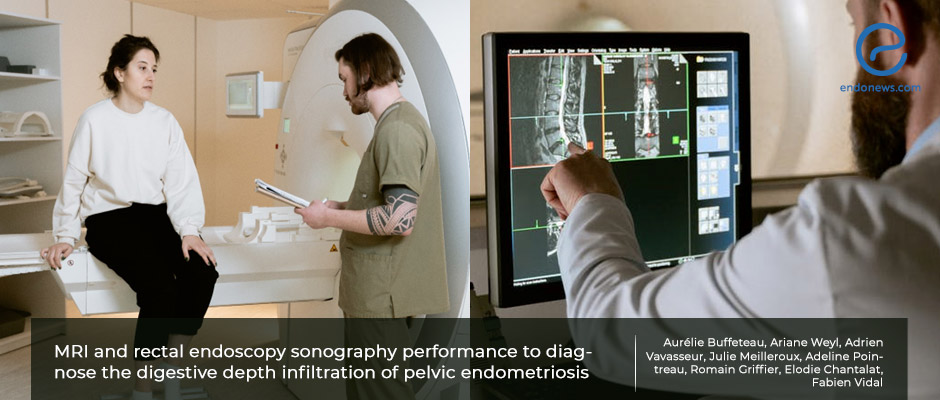Comparison of imaging techniques for estimating the depth of bowel wall infiltration by endometriosis.
Jun 9, 2022
MRI and rectal endoscopic sonography show similar performance in terms of digestive involvement by deep infiltrating endometriosis, but their complementary use is still helpful
Key Points
Importance:
- The appropriate preoperative prediction for the endometriotic lesion depth by imaging techniques is important.
Highlights:
- MRI and RES showed similar results for the presence of digestive involvement, however, despite their high sensitivity, the specificity was low for both techniques.
What's done here:
- This single-center retrospective study aimed to evaluate the performances of MRI and rectal endoscopy sonography (RES) in predicting the depth of bowel wall infiltration by endometriosis.
- Fifty-two women who had a discoid or segmental resection for removal of DIE were enrolled in the study, encompassing the period from April 2014 to March 2020.
- The preoperative MRI and RES findings were statistically compared to gold standard histopathology.
Key Results:
- Surgical resections were made either by conventional or robotic laparoscopy and mainly located in the rectum and/or sigmoid colon.
- All patients were diagnosed with deep infiltrating endometriosis.
- Histopathological examination showed digestive involvement in 92.3% of patients, with 38.4% mural infiltration; however, the suspected mural involvement for both MRI and RES was over 80%.
- The intermodality agreement between MRI and RES was around 85% with a moderate kappa value, and the sensitivity was high (95%).
- The specificity of both techniques was low, 0.28.
Strength and the Limitations:
- The blind review of all MRI, and histopathology by the same clinicians, and the performance of all RES in a single center by two experts, are the strengths.
- The retrospective nature of the study and the power of analysis that was hindered by the small sample size are the limitations.
Lay Summary
The surgical removal of deep endometriosis is the cornerstone of the management. However, the decision for the varying surgical approach types ranging from conservative management (shaving) to segmental or discoid resection depends on the depth of infiltration within the bowel wall, which should be assessed by appropriate preoperative imaging workup. In other words, preoperative workup influences the course of surgery, the need for a multidisciplinary surgical team, and the postoperative course of the disease. However, there is currently no strict recommendation on the surgical technique choice based on the pre-and perioperative lesion characteristics. In fact, MRI (magnetic resonance imaging) and rectal endoscopic sonography (RES) are complementary because ultrasound also provides the diagnostic precision that is essential to adapting the surgical procedure.
Dr. Buffeteau and colleagues from Toulouse, and Bordeaux, France, conducted a single-center, retrospective study on 52 patients with deep digestive tract endometriosis to compare two imaging techniques, namely MRI and RES in predicting the depth of bowel wall infiltration by endometriosis.
The preoperative MRI and RES findings of 52 women were statistically compared to gold standard histopathology. Histopathological examination showed digestive involvement in 92.3% of patients, with 38.4% mural infiltration; however, the suspected mural involvement for both MRI and RES was over 80%. Although the intermodality agreement between MRI and RES was around 85% with a moderate kappa value, and their sensitivity was high (95%); the specificity of both. techniques were low, 0.28.
In conclusion, the authors found similar performance for MRI and RES in terms of digestive system infiltration by DIE, with 85% agreement between the two modalities but a low degree of specificity for both techniques. This study suggests that performing a second-line examination is not useful if there is no transmural impairment in one of the techniques. However, when there is a wall involvement, the combination would help to guide surgical management as effectively as possible, thinking of the important additional information provided by RES such as the lesion volume, the circumference of bowel infiltration, and multifocality, along with the possibility of bowel biopsy when necessary. However, the lack of specificity demonstrated in their data still argues for the development of new tools for preoperative evaluation for providing a more personalized approach.
This interesting study was recently published in the journal named Archives of Gynecology and Obstetrics.
Research Source: https://pubmed.ncbi.nlm.nih.gov/35435484/
deep infiltrating endometriosis bowel MRI rectal endocopy sonography endometriosis.

